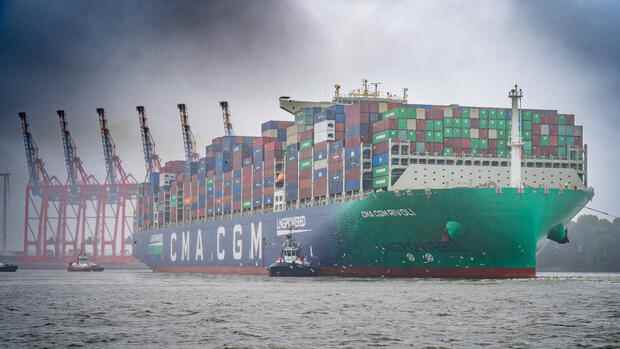Dusseldorf Renewed waves of strikes in Germany and the USA are increasing concerns about even more serious traffic jams in seaports worldwide. Corona-related lockdowns and labor disputes in container shipping have been causing delivery bottlenecks since autumn 2021, which are likely to get worse in the coming weeks.
Because if the collective bargaining parties do not agree at the last minute, the workers in the German seaports will stop working for 48 hours from Thursday. That would be the longest strike on the coast in the history of the Federal Republic, reports the TV station NDR. It is expected that no ships would be unloaded until Saturday morning.
As early as June 9th, dockworkers in Hamburg, Bremerhaven, Bremen, Wilhelmshaven, Emden and Brake on the Lower Weser had suspended their work for a day. Another warning strike followed three weeks ago.
The employers, organized in the Central Association of German Seaport Companies (ZDS), had increased their offer to a salary increase of 12.5 percent in the most recent round of collective bargaining. But that’s not enough for the employees, the Verdi union is demanding up to 14 percent for the around 12,000 employees in the 58 collective bargaining companies. That would put an additional burden on Germany’s ports, for which the higher wages of employees are already a competitive disadvantage compared to Dutch and Belgian ports. This was pointed out by the Hamburg logistics management professor Jan Ninnemann in a study a few months ago.
Top jobs of the day
Find the best jobs now and
be notified by email.
Maritime traffic to and from Germany is already disrupted. At the end of last week, around two percent of the global container fleet was backed up in the German Bight, according to calculations by the Kiel Institute for the World Economy (IfW Kiel). In Germany’s largest port in Hamburg on the Elbe, 13 ships are currently waiting to be cleared, the online forwarding company Flexport reported on Wednesday – significantly more than in the direct competing ports of Rotterdam and Antwerp.
Mega strikes threaten US ports
Additional dangers for the global supply chains also threaten in the USA. It is not only the ongoing wage negotiations of the dockworkers’ unions on the US west coast that are causing unrest there. US-wide work stoppages are also threatening railroad employees and truck drivers. The US Chamber of Commerce fears that they could massively slow down delivery traffic to the ports on both coasts. Already at the beginning of the year, massive freighter traffic jams off Los Angeles, Long Beach, Seattle, Savannah and New York had thrown the container sea services out of sync.
The scenario could now repeat itself. “Two months ago we saw some light at the end of the tunnel,” reports Kühne+Nagel CEO Otto Schacht. “Now it’s getting dark again.” The number of containers waiting to be loaded has doubled in US ports since the beginning of June. In Savannah, the largest port on the east coast, the waiting time is now almost eight days, three times longer than at the end of May.
The U.S. Chamber of Commerce has since written to President Joe Biden’s U.S. administration asking it to “help resolve ongoing labor negotiations between railroads and the 12 railroad unions by following historical precedent and appointing a Presidential Emergency Board (PEB),” reports the American logistics service “Splash”.
>> Read also: Freight rail chaos in Germany: industry expects damage in the billions
The Chamber of Commerce warns that the government must act to prevent disruptions to American rail traffic. The PEB panel would have 30 days after appointment to make recommendations to resolve the disputes. Unless the parties agree, workers are not allowed to go on strike during this period and for 30 days after the publication of the recommendation report. Employers are also not allowed to unilaterally change the terms of employment or exclude their workers.
Deceptive calm in China
On the other hand, at the other end of the shipping routes to the Far East, in the ports of Shanghai, Ningbo and Yantian, there is currently a deceptive calm. The situation there has eased in recent weeks, reports the online freight forwarder Flexport. “Chinese ports are operating under normal conditions and port congestion has eased,” the latest update to customers said. Most ships that are waiting for anchorage are currently only expected to wait a maximum of one or two days.
But even here, a high degree of uncertainty remains. In Shanghai, a mass testing campaign for all residents in nine of the 16 districts started this week. The omicron variant BA.5 has once again increased the number of infections. The lockdowns in the spring hit the world’s largest seaport hard and caused disruptions in maritime traffic, which also led to delivery bottlenecks in Europe.
In addition, there are currently lockdowns in the Chinese steel metropolis of Wugang and in another 30 cities in the north-west of the country. On Monday, the logistics platform Zencargo warned: “While the increase in cases has not yet impacted deliveries, there are growing concerns that local lockdowns in China will lead to further congestion in already strained ports.”
In addition to the restrictions, bad weather could cause delivery bottlenecks in China: numerous Chinese ships have been delayed by typhoons in the past few days. As a result, fewer ships initially arrived in the ports of Ningbo, Shenzhen and Hong Kong.
The global obstacles hit logistics at an unfavorable time: In August, i.e. in two weeks, the high season for container shipping begins in order to be able to supply consumers with goods on time for Black Friday and in Advent.
More: Why Hapag-Lloyd equips millions of containers with sensors
